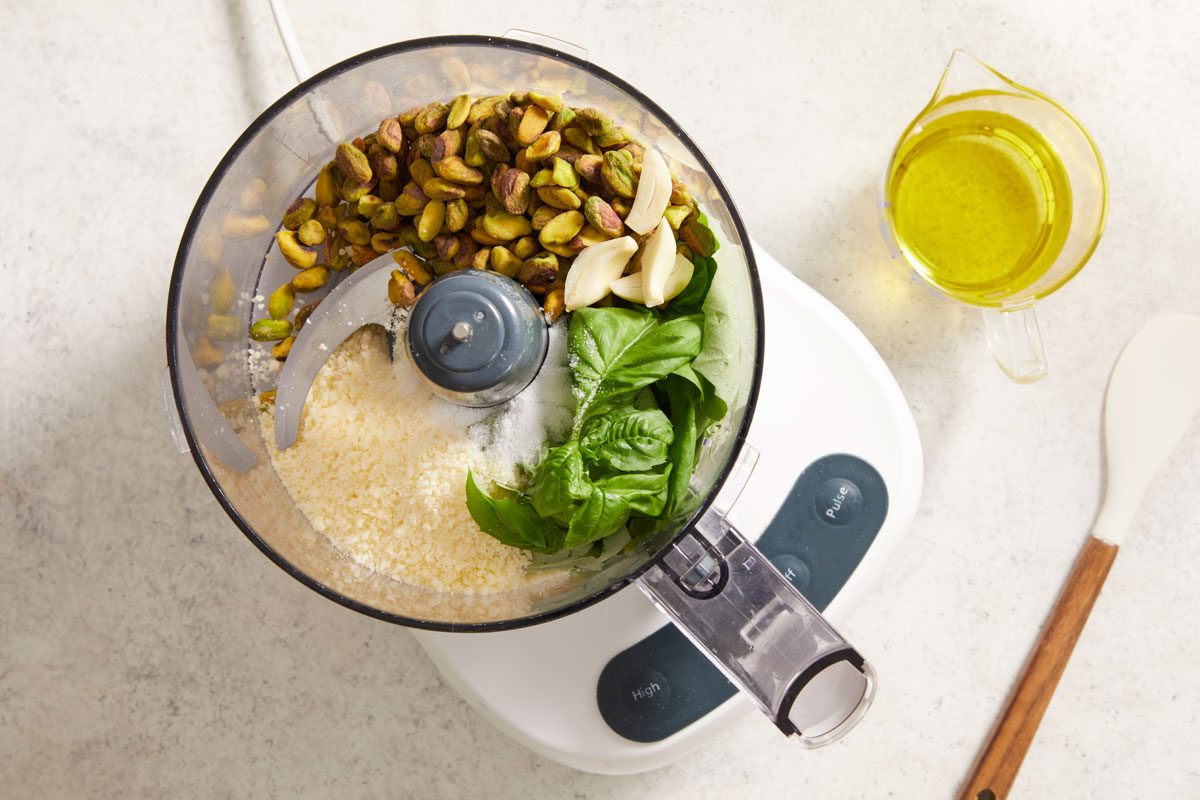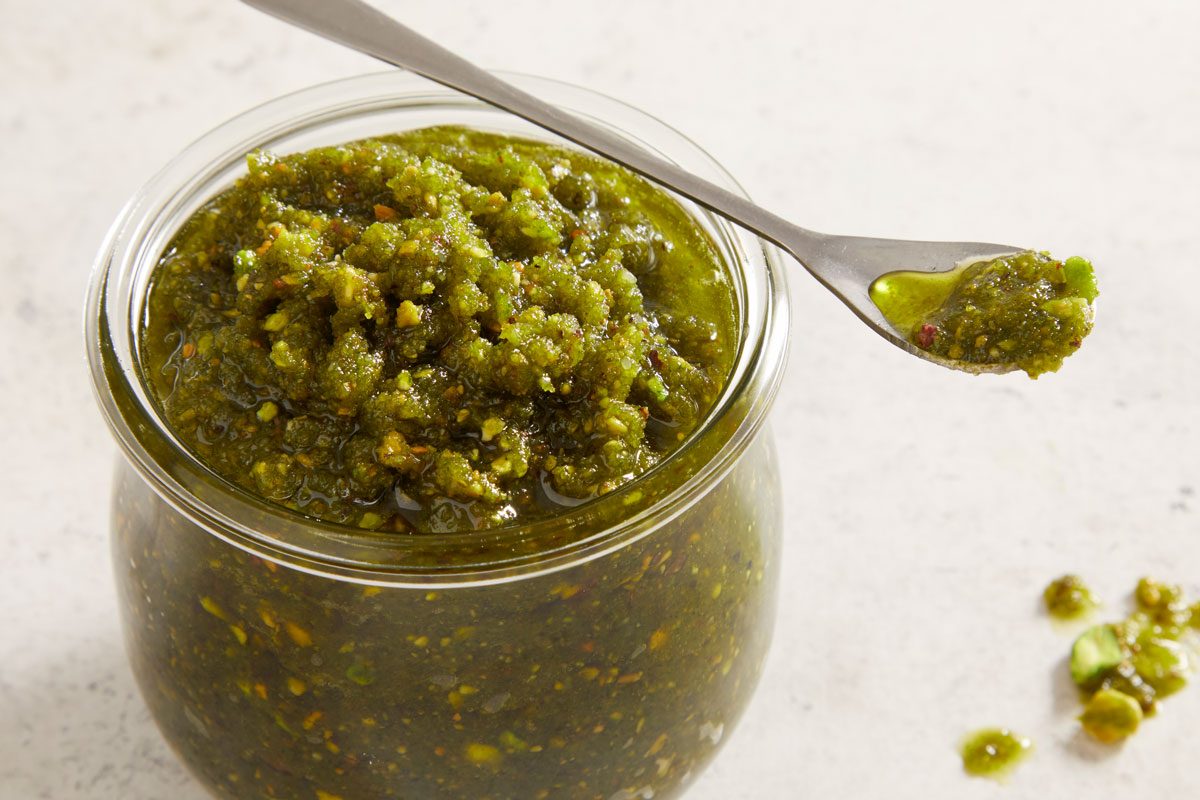A delicious twist on the classic basil spread, Sicilian pistachio pesto has exceptional flavor and a lovely green color.

Pistachio Pesto

Although most of us are primarily familiar with pesto made from basil and pine nuts, in Italy, where the famous spread originated, they make all kinds of pestos with different herbs, nuts, cheeses and oils, plus other flavorful additions. Many of these spreads are regionally specific, using the best of what is grown and produced in the vicinity. Pistachio pesto comes from the region of Sicily around Mount Etna—the only place in Italy boasting pistachio orchards.
Aside from pistachios, the other ingredients are the same as those in classic pesto, including olive oil, garlic and Parmesan cheese. Use pistachio pesto wherever you’d use the pine-nut version: pastas, sandwiches, pizza, soups and beyond.
Pistachio Pesto Ingredients

- Pistachios: Pistachios originated in Iran and Central Asia, but most American pistachios are grown in California. Lightly toasting nuts before blending with the other ingredients is optional, but it will add more depth of flavor to the pesto.
- Parmesan cheese: With its robust flavor and firm texture, Parmesan is perfect for pesto. For this recipe, seek out the best Parmesan you can find and grate it yourself with a rasp. This recipe is a great time to use real Italian Parmigiano-Reggiano.
- Garlic: Garlic gives pesto its zing. If you’re a serious garlic lover, increase the number of cloves.
- Salt: Salt enhances the flavors in the pesto and acts as a preservative. Don’t hesitate to taste the pesto and season it to taste as you go.
- Basil: Bright green Genovese basil gives pesto its signature color and flavor. Because the herb is so delicate and sensitive to cold, be careful how you store fresh basil. When possible, buy basil the same day you wish to use it, or keep it on the counter for a day or two with its stems in water. Or grow basil indoors for use anytime!
- Olive oil: The olive oil will stand out in a simple recipe such as this one, so use a high-quality, extra virgin olive oil for pistachio pesto.
Directions
Step 1: Make the pesto

Place the pistachios, Parmesan, basil, garlic and salt in a food processor.

Cover and process until the ingredients are blended.

While processing, gradually add oil in a steady stream.

Once the pesto is fully blended, transfer it to an airtight container or use it immediately.

How to Use Pistachio Pesto
- Toss it with pasta: In Sicily, cooks toss pistachio pesto with orecchiette—a fun pasta shape that looks a bit like ears—but it’s great with any type of pasta. Use the spread to make pesto lasagna, add it to the filling for stuffed pasta shells or the sauce in your favorite mac-and-cheese recipe.
- Add it to salad dressing: Add a scoop of pesto to a vinaigrette or creamy dressing, such as buttermilk blue cheese or ranch dressing.
- Use it as a condiment or sauce: Slather pistachio pesto on pizza dough in place of marinara sauce, mix it into mayonnaise as use it as a sandwich spread by mixing it into mayonnaise or by spreading it directly on bread, or use it as a sauce for seafood.
- Stir it into cold salads: Pasta salad is an obvious match for pesto, but it’s far from the only one. Mix the green stuff into potato salad, chicken salad, tomato and fresh corn salad, or cannellini bean salad. It’s incredibly versatile.
Pistachio Pesto Variations
- Add other herbs: Although basil is classic, plenty of herbs taste wonderful in pistachio pesto. Sage makes a fragrant addition, and parsley is also a good choice. A little bit of oregano or spearmint would be lovely, too. In this case, tender herbs work better than woody herbs (such as rosemary).
- Change the oil: For even more pistachio punch, replace some of the olive oil with pistachio oil. Or, to mellow out the pesto, use a neutral healthy oil instead of some or all of the olive oil. Sunflower oil, avocado oil or grapeseed oil would do the trick.
- Swap the cheese: Parmesan is the classic cheese used for pesto sauce recipes, but there are plenty of other cheeses that would work just as nicely, especially other hard grating cheeses such as pecorino Romano or Grana Padano. For a creamy pesto, you could add ricotta, instead.
- Include some citrus: In addition to helping keep pesto brightly colored, lemon juice and lemon zest also brighten its flavor. You can also use orange juice and orange zest.
How to Store Pistachio Pesto
This pistachio pesto recipe can be stored in a glass container with an airtight lid, or in a zip-top bag that allows you to press out the excess air. If using a container, cover the top of the pesto with olive oil as you package it, which helps protect it from the oxygen exposure that turns it brownish.
How long does pistachio pesto last?
When properly packaged and stored in the fridge, pistachio pesto will last around five days.
Can you freeze pistachio pesto?
Yes, pesto with pistachio nuts freezes beautifully. Freeze it in sealed zip-top bags with the air pressed out, or in oiled ice cube trays. In the latter case, pop out the frozen cubes and transfer them to a bag. Use the pesto within a year.
Pistachio Pesto Tips

How do you keep pistachio pesto green?
There are a few tricks to keeping pesto green. One way is to blanch the basil—drop it briefly in simmering, salted water to set the color. However, blanching diminishes the herb’s flavor and health benefits.
Another way to keep pesto brightly colored without sacrificing flavor and vitamins is to add a bit of lemon juice to the recipe. You can also process the pesto with an ice cube in the mix. If storing it in a container, add olive oil to the top before closing the lid to prevent oxidation. Storing it in a baggie and squeezing out all of the air is another option.
Should you toast pistachio nuts for pesto?
Toasting nuts for pesto is a personal choice. Pistachio pesto sauce made with toasted nuts will have a deeper, nuttier flavor, while the same recipe made with raw nuts will allow the basil, garlic and olive oil to pop a little bit more. Both are wonderful.
Ingredients
- 1 cup pistachios
- 1/2 cup grated Parmesan cheese
- 2 garlic cloves, halved
- 1 teaspoon salt, optional
- 1 cup fresh basil leaves
- 1/2 cup plus 2 tablespoons olive oil
Directions
- Place the pistachios, parmesan, basil, garlic and salt in a food processor; cover and process until blended. While processing, gradually add oil in a steady stream. Store in an airtight container in the refrigerator for up to 5 days or freeze for up to 1 year.


















